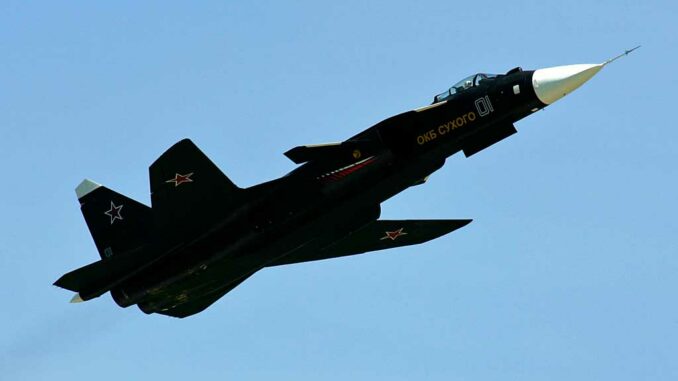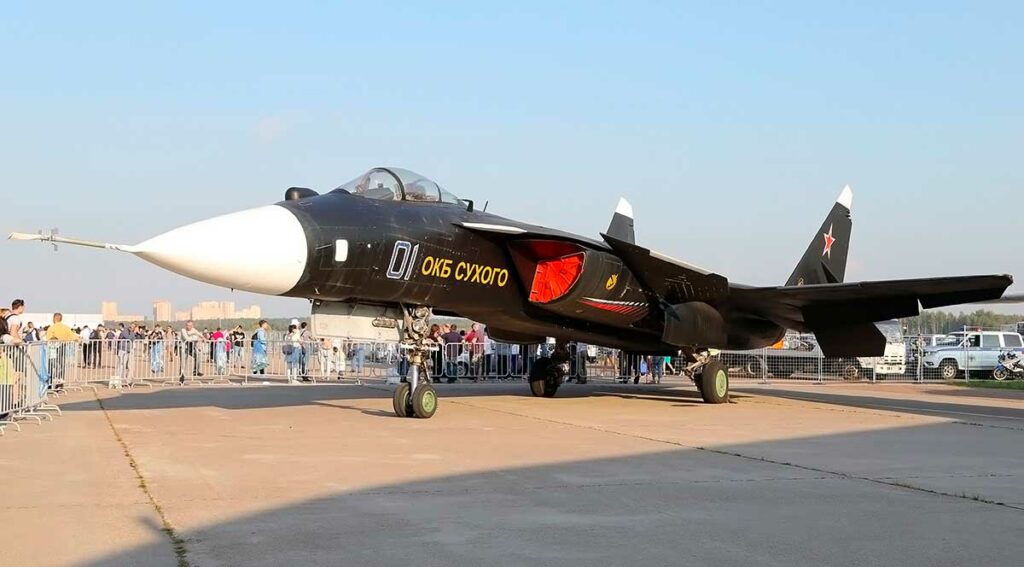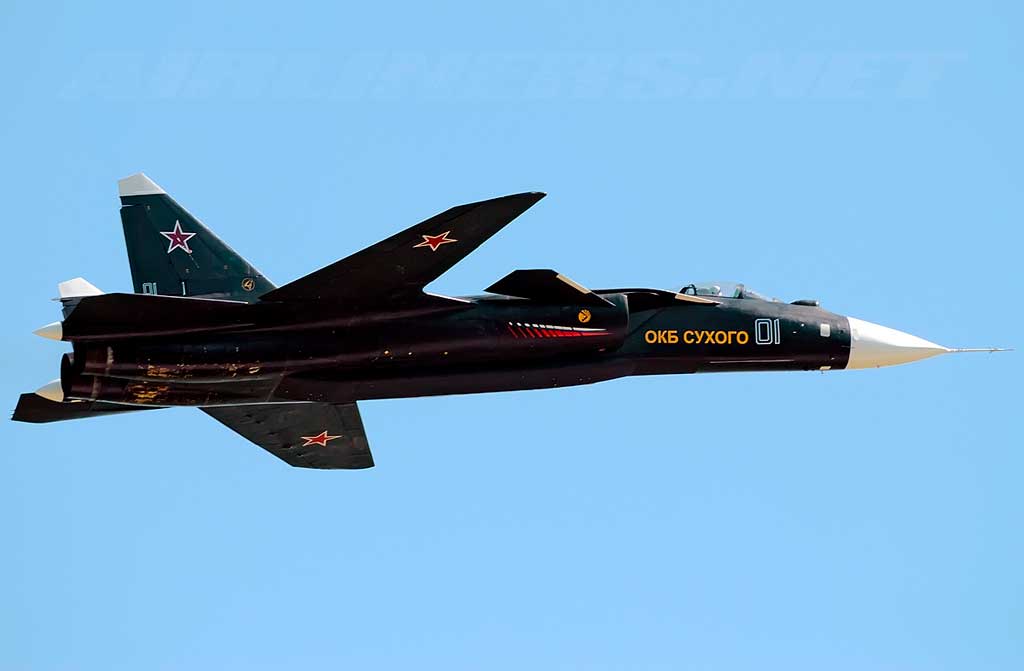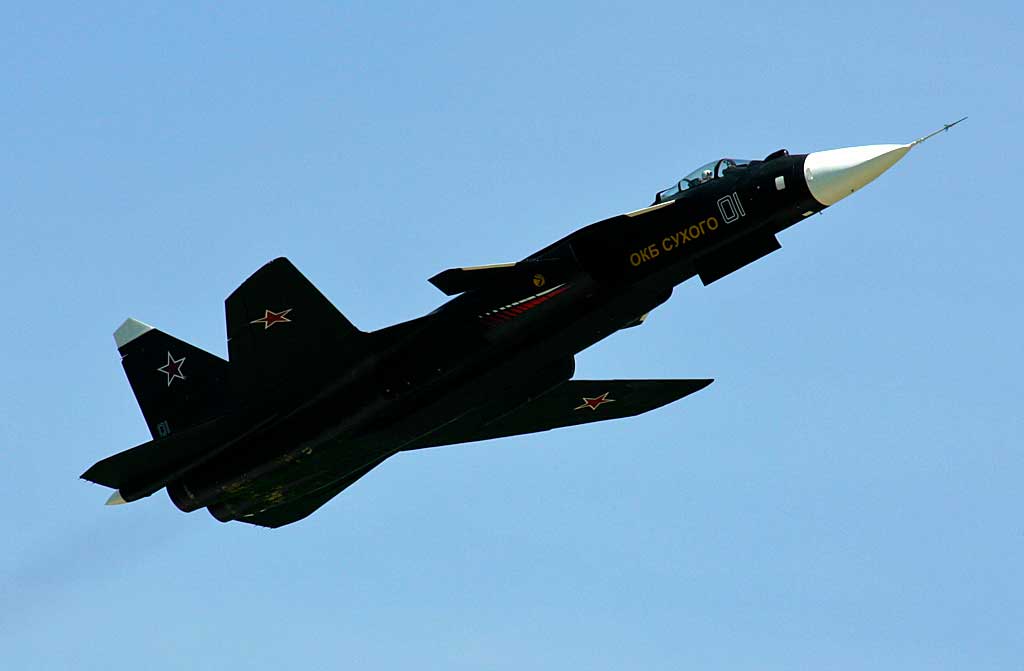
Detailed study of the Sukhoi Su-47 Berkut, a Russian experimental aircraft with inverted swept wings, designed to test advanced technologies.
The Sukhoi Su-47 Berkut is a Russian experimental fighter aircraft developed in the 1990s. Designed to explore advanced technologies, it is distinguished by its swept-back wings and increased maneuverability. Although it never entered production, the Su-47 served as a test bed for innovations that were later incorporated into aircraft such as the Su-57. This article examines in detail the technical, military, and scientific aspects of this unique aircraft.

Aerodynamic design and technological innovations
The Sukhoi Su-47 Berkut is a technology demonstrator designed to validate unconventional aerodynamic concepts and assess their viability on a new-generation fighter aircraft. Three main elements structure its experimental design: swept-back wings, electric flight control architecture, and extensive use of composite materials. These technical choices were made to improve maneuverability, low-speed stability, and high-angle-of-attack capabilities, while maintaining a structure resistant to extreme mechanical stresses.
Forward-swept wings: configuration and aerodynamic behavior
The Su-47 is characterized by forward-swept wings, inclined at +20° to the longitudinal axis of the aircraft. This configuration differs from the traditional (rearward) sweep typical of fighter aircraft since the 1950s. One of the main aerodynamic advantages of this arrangement is improved boundary layer behavior, particularly at high angles of attack. Unlike a conventional wing, the reverse sweep allows airflow to be directed towards the wing root rather than the wing tip. This reduces the risk of premature stall of the wing tips and allows for better roll and pitch control, even at low speeds.
This behavior is particularly useful in close combat, where aircraft must maneuver at reduced speeds while maintaining their aerodynamic efficiency. In addition, the reverse sweep promotes better lift distribution, which improves longitudinal stability without lengthening the horizontal tail. With a wingspan of 16.7 meters and a wing area of nearly 62 m², the Berkut is therefore capable of producing significant lift at angles of attack greater than 45° without causing a sudden stall.
However, this configuration also has undesirable mechanical effects. The main constraint is the phenomenon of divergent torsion: under aerodynamic load, the wing tips tend to roll upward, locally increasing the angle of attack and aggravating structural loads. In the long term, this leads to risks of breakage or permanent deformation. For this reason, reverse sweep is rarely used on operational aircraft.
Electric flight controls: instability control
The Su-47 is inherently unstable in the longitudinal and lateral planes. This instability is intentional: it increases the aircraft’s responsiveness, which is desirable in an air superiority aircraft. To make the aircraft flyable despite these characteristics, Sukhoi engineers integrated a three-channel redundant digital fly-by-wire flight control system.
This system measures flight data (angle of attack, acceleration, speed, attitude) in real time and calculates the corrections to be applied to the control surfaces (flaps, ailerons, rudder, canards). The on-board computer processes these signals several hundred times per second and continuously adjusts the control surfaces, even without direct commands from the pilot. This system has two advantages: it actively compensates for aerodynamic instabilities and allows flight regimes that would otherwise be impossible to control manually.
In the specific case of the Su-47, fly-by-wire is essential to take advantage of the atypical aerodynamics without compromising flight safety. For example, this system allows maneuvers at more than +9 g while maintaining precise control of the aircraft, particularly during high-angle turns or complex aerobatic maneuvers.
Composite materials: structural rigidity and weight reduction
The other major constraint associated with the inverted sweep is the mechanical strength of the wings, which are subjected to significant bending and torsional loads. To address this, the Su-47 uses a high percentage of composite materials, accounting for more than 13% of the aircraft’s total weight and more than 90% of the external surface of the wings. These composites are mainly based on carbon fibers combined with high-performance epoxy resins.
These materials were chosen to maintain sufficient structural rigidity while reducing overall weight. By comparison, an aluminum wing subjected to the same stresses would be significantly heavier to achieve the same torsional tolerance. By lightening the airframe, engineers were able to improve the aircraft’s thrust-to-weight ratio and optimize overall maneuverability.
In addition, composites offer better resistance to corrosion and fatigue, which are essential for prolonged testing of a prototype. The combined use of composite materials and advanced mechanical modeling techniques has enabled the Su-47 to validate in flight a configuration that was previously considered unrealistic for a large jet aircraft.

Technical specifications
- Length: 22.6 meters
- Wingspan: 16.7 meters
- Height: 6.3 meters
- Wing area: 61.87 m²
- Empty weight: 16,375 kg
- Maximum takeoff weight: 34,000 kg
- Maximum speed: 2,500 km/h (Mach 2.1)
- Operational ceiling: 18,000 meters
- Range: 3,300 km
- Climb rate: 233 m/s
- Maximum load factor: +9 g
Propulsion
The Sukhoi Su-47 Berkut is equipped with two Perm Aviadvigatel D-30F6 turbojet engines, identical to those that power the MiG-31 interceptor. Each engine develops a thrust of 93 kN dry and reaches 152 kN with afterburner (approximately 15,500 kgf). This engine places the Su-47 in the heavy fighter category, with a favorable thrust-to-weight ratio in certain configurations.
The D-30F6 engines are twin-spool engines with afterburners, designed for high-speed and high-altitude flight. They enable the Su-47 to reach a maximum speed of Mach 2.1, or approximately 2,500 km/h at high altitude, and climb to an operational ceiling of 18,000 meters. The climb rate exceeds 230 meters per second, ensuring rapid interception capability.
However, these engines were chosen primarily for reasons of availability and compatibility with the experimental airframe. The Su-47 was never intended to enter series production, and the use of the D-30F6 was a pragmatic, albeit imperfect, solution. This engine, although robust, is relatively old and does not offer thrust vectoring or variable flow control, which limits extreme maneuverability at low speeds. Initial plans called for the introduction of AL-41F turbojet engines or modified versions with swivel nozzles, but these developments remained theoretical.
Mission systems and armament
The Su-47 is equipped with a modular mission suite, designed primarily for integration testing. Its armament remains symbolic, intended to validate configurations rather than provide real operational capability. It has a 30 mm GSh-30-1 cannon integrated into the right side of the fuselage, with a stock of 150 shells.
For stealth configuration testing, the aircraft includes an internal bay capable of carrying several types of air-to-air missiles. Among those tested are the Vympel R-73 (short range) and R-77 (medium range), as well as the heavy R-33, generally used on the MiG-31. The aim was to validate firing from a closed bay in order to reduce the radar signature.
The Su-47 served as a platform for testing concepts integrated into the Su-57: internal bay, assisted piloting, sensor architecture, and radar cross-section reduction.

Role and impact on future development
The Sukhoi Su-47 Berkut was never designed as an operational fighter. From the outset, it was intended as a flying test bed to validate technological solutions for a future generation of Russian combat aircraft. Its main role was to demonstrate the performance and limitations of certain aerodynamic, structural and electronic innovations under real conditions.
Among the most significant lessons learned was the validation of the behavior of swept-back wings. Although this configuration was not retained on production fighters, it provided valuable aerodynamic data, particularly in terms of high-angle control and lateral stability. This data was used to optimize the wing profile and control systems of the Su-57.
The Su-47 also enabled extensive testing of the integration of composite materials into the airframe. The use of these materials over large areas and in critical areas helped define manufacturing protocols and mechanical tolerances for subsequent aircraft. This expertise was reused on the Su-57 prototypes, whose structure incorporates more than 25% composites by mass.
Finally, the Su-47’s fly-by-wire flight control system provided an experimental basis for developing a redundant digital architecture, which is necessary on unstable and maneuverable airframes. The development of the Berkut’s onboard intelligence and multi-axis computers influenced the Su-57’s flight control systems.
The Su-47 Berkut played a pioneering role in the technological development of Russian combat aviation. Although only one model was ever produced, its industrial and operational benefits have been incorporated into fifth-generation platforms, confirming its strategic value in the Sukhoi program’s innovation chain.
War Wings Daily is an independant magazine.